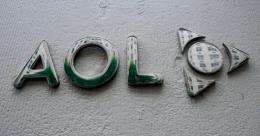AOL going public after Time Warner divorce

AOL finalized its divorce from Time Warner on Wednesday, ending one of the most disastrous marriages in corporate history and leaving the Internet pioneer facing an uncertain future.
AOL common stock begins trading on the New York Stock Exchange on Thursday, a little more than six months after media and entertainment giant Time Warner decided to cut its losses and spin off the ailing Internet unit.
While the AOL of 2001 was worth as much as 165 billion dollars, prior to the bursting of the dotcom bubble, the AOL of 2009 is valued at just 2.8 billion dollars according to analyst Ross Sandler of RBC Capital Markets Corp.
As broadband takes over and its dial-up Internet-access business wanes, AOL chief executive Tim Armstrong, who was hired away from Google in March, said the independent AOL would be focused on "content, ads and communications."
"Today we're producing about 80 percent of our own content," Armstrong, who was a senior vice president at Google, told financial analysts at the UBS Global Media and Communications Conference in New York on Wednesday.
He said that when he took the reins at the Dulles, Virginia-based AOL "there were 24 ad systems, there were 17 content management systems (and) none of them had been integrated together."
Armstrong said AOL would now be working from a global platform which would help determine "what types of content to produce, when, how and where it's going."
AOL, currently the number four gateway to the Web after Google, Microsoft and Yahoo!, is focused on "building deep rich content that's shareable, that people like," he said.
In a kickstart for the launch of its new content management platform Seed.com, AOL announced Tuesday that it had hired veteran technology reporter Saul Hansell of The New York Times as programming director.
On the advertising side, Armstrong said he expects to see growth in AOL's display advertising business.
AOL was testing a new ad platform that will launch next year that is "very good at display targeting," he said. "It will be open to all ad customers. They can use credit cards to sign up.
"If we can't make that business work, I think we have big issues," he added.
Armstrong said AOL was "marginally profitable" but cautioned not to expect an immediate turnaround in the company's fortunes.
"It's not going to be 2010 and hopefully it's not going to five years from now," he said. "It'll be sometime in between those two timeframes."
On the communications side, Armstrong said AOL has tens of millions of people using its instant messaging and email services and the company was committed to those products.
"Email in the United States at least is still a growth market," he said.
AOL's email currently holds fourth position behind Yahoo! Mail, Microsoft's Hotmail and Google's Gmail in the United States.
Armstrong pointed to online map service Mapquest as a strong AOL property.
Mapquest has been losing market share to Google Maps, but Armstrong said it is a "very, very valuable property, probably one of the most valuable brands on the Internet.
"A number of partners have approached us about Mapquest," he said.
Armstrong also said morale was good at AOL despite plans announced last month to cut some 2,500 jobs as part of a plan to save 300 million dollars.
The cuts will leave AOL with around 4,400 employees, a far cry from the 19,000 of 2006 and less than a quarter of the number of workers at Google, which barely existed at the time of the ill-fated AOL-Time Warner merger.
Time Warner merged with America Online in 2001 at the height of the dot-com boom with AOL using its inflated stock as a currency for the transaction.
Time Warner was forced in 2002 to massively write down the value of AOL and the AOL name was removed from the group's corporate title in 2003.
(c) 2009 AFP


















